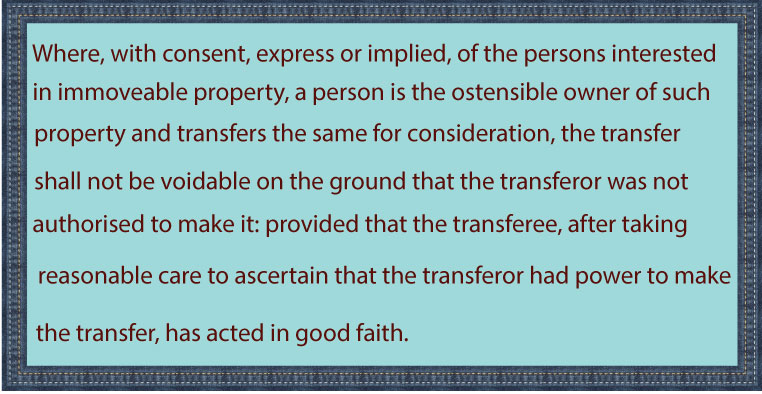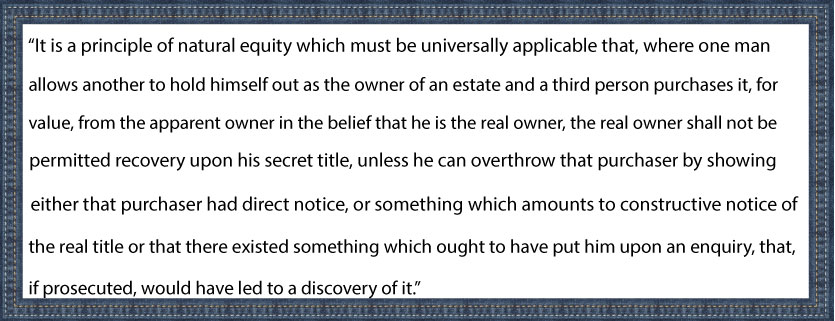In this blog we will discuss section 41 of the Transfer of Property Act, 1882. We will explain in detail who is an ostensible owner, the differences between ostensible owner and real owner, who cannot be ostensible owner, the rules laid down by section 41, the analysis and effects of section 41 and the burden of proof with relevant case references.
Introduction
In simple words, the term ‘ostensible’ means which appears to be true but in reality, it is not true. According to Black’s Law Dictionary, ‘ostensible ownership’ connotes to an apparent ownership emanated from conducts or words. Benami transaction is an example of ostensible ownership. Benami transaction implicit that the property is held by one person while, the consideration for the same is granted by another. The concept of transfer by ostensible owner is incorporated under section 41 of the Transfer of Property Act.
Who is the ostensible owner?
An ostensible owner is the one who has all the sign of ownership without being the original owner. Seemingly, such an owner of a property looks like a real owner but if inspected carefully, it may be found that although his/her name appears in the records and title-deeds and he/she also possess the property but he/she had no intention to own that property. Ostensible owner behaves like the original owner of a particular property with the consent whether implied or express of the original owner. Ostensible owner of a property merely holds the property and represents himself/herself as an original owner to the third parties. Ostensible owner is the full but unqualified owner or holder of the property.
Differences Between Ostensible Owner and Real Owner
According to Austin, there are three attributes of ownership namely, it is a right indefinite in point of user, unrestricted in point of disposition and unlimited in point of duration. No restriction can be imposed upon the real owner of property in respect of transferring his property to anyone. The real owner is the full and qualified owner of the property. The real owner also has the intention to hold the property for himself and his heirs. In contrast, the ostensible owner is a full but ‘unqualified owner’ of the property. Ostensible owner holds the property because the real owner has given the consent and allowed him the right to hold the property. The real owner must have the knowledge that ostensible owner is holding the property out.
Who cannot be an ostensible owner?
The following persons are not permitted to be ostensible owners.
- Professed agents
- Guardians
- Trustee
- Servant
- Any person acting in fiduciary character
The Rules Laid Down by Section 41 of TPA, 1882
Section 41 of TPA says,
According to section 41 of TPA, 1882 ‘where the transferor is an ostensible owner of the property with the consent of the real owner and that ostensible owner transfers the property to a bona fide purchaser for consideration, if the purchaser in good faith, after taking reasonable care to ascertain whether the transferee had the power to make the transfer, has purchased the property then the transfer cannot be voidable due to the fact that the transferor is not authorized to make the transfer.’
Rule of Estoppel
The real owner under section 41 of TPA, 1882 will be estopped or prevented from recovering his/her property from the bona fide purchaser on the ground that the transferor was not competent to make the transfer. The doctrine of estoppel is applied to the real owner because he has given consent express or implied to the ostensible owner to hold the property out.
Rule of Caveat Emptor
The Latin term caveat emptor means that ‘let the buyer be aware’. This rule required the transferee apart from acting in good faith, to take all reasonable care to apprise himself of any defect in transferor’s title or clog on his power to affect the transfer. It is essential that the purchaser as a man of ordinary prudence has inquired diligently and has made himself satisfied about the title of the transferor.
The Underlying Principle of Section 41 of TPA, 1882
The doctrine of transfer by ostensible owner is derived from the Latin maxim ‘nemo dat quod non habet’ which means ‘no one can confer a better or higher right to property than what he himself possesses’. The doctrine of transfer by ostensible owner is exception to this general rule.
The doctrine is based on the principle of natural justice, equity and good conscience. The main principle of section 41 is that ‘where one of two innocent persons must suffer from the fraud or malice of a third party, the loss should fall on him who has created or had power to prevent the opportunity for the fraud or malice; and in such situation hardship is caused by the strict enforcement of the general rule.’
The application of doctrine of transfer by ostensible owner was firmly established in the Indian Sub-continent after the observation made by Privy Council in the case of Ramcoomer Kundoo v McQueen [1872]
Essential Ingredients of Section 41 of TPA, 1882
The followings are the essential ingredients of section 41 of TPA, 1882.
- The transferor must be an ostensible owner;
- The transferor must be an ostensible owner with the consent express or implied, of the real owner;
- The transfer should be for consideration;
- The transferee must have acted in good faith and have taken reasonable care to ascertain that the transferor had the power to transfer.
If the above-mentioned conditions are fulfilled then the transfer is valid in the eye of law.
Analysis of section 41 of TPA, 1882
Consent of the real owner
The real owner of the property must give permission or consent to the ostensible owner to hold the property out. The consent of the real owner may be express consent or implied consent. Consent of the original owner can be inferred from his words, conducts or acts. If the owner allows the ostensible owner to hold the property out without saying anything then implied consent arises. If the real owner was under obligation to speak but he did not speak then his acquiescence will amount to consent.
The consent of the real owner must be a free consent, which is given voluntarily in a free will. Under section 14 of The Contract Act, 1872, the definition of free consent is given. A consent will be free and valid, if it is not a consequence of –
- Undue influence
- Coercion
- Fraud
- Misrepresentation
- Mistake
Reasonable Care
The reasonable care and inquiry taken by the transferee must be diligent not superficial. The transferee needs to inquire the fact as a man of ordinary business or a person of ordinary prudence. The inquiry taken by the transferee must have a specific starting point or specific circumstances which must be expected to be led to some outcome. What would be ‘reasonable’ is a question of fact. Under section 41 of TPA, 1882 reasonable care demand the purchaser/transferee to inspect the ‘title-deeds’ under which the ostensible owner claims the title and to confirm if the transferor has the authority to transfer under the deeds. If the purchaser does not fulfil the requirement of reasonable care then he cannot claim the protection and the principle that ‘a man cannot give what he has’ not must apply.
Good Faith
The purchaser must act in a good faith in respect of buying the property. The standards of good faith are –
- There must be an honest dealing between the parties;
- There must be an honest belief that the ostensible owner was the real owner;
- The purpose of the transaction needs to be honest;
- There must exist faithful performance of duties;
- There must be an absence of fraudulent or malice intent.
Effects of section 41 of TPA, 1882
The real owner cannot challenge or question the transfer made by ostensible owner when he himself has allowed the ostensible owner to hold property out. Under this section the successor-of-interest of the real owner is also estopped from challenging the transfer. If the requirements of this section are fulfilled then the transfer by ostensible owner will not be ‘voidable’ on the ground that he was not authorized to make the transfer.
If the real owner wants to overthrow the purchaser, he must prove that –
- The purchaser had direct notice or something which amounts to constructive notice of the real title.
- There were existed circumstances, which ought to have put the purchaser on an enquiry, which if prosecuted would have led to a discovery of it.
If the real owner fails to prove these, he has no remedy against the purchaser.
Exceptions to section 41 of TPA, 1882
In the following cases, this section does not apply –
- Transfer in invitum by order of court
- Purchase of equity of redemption
- Auction Sales
- Tenancies
- Execution Creditors
- Religious Endowments
- Adverse Possession
Burden of Proof
The burden of proof is always on the purchaser to prove that he is a bona fide purchaser and he acted in good faith with proper care and that his transferor was ostensible owner with the consent of real owner.
Case References
Najam Ali Shah v Additional Deputy Commissioner [2001] YLR 2502
The purpose of section 41 of TPA, 1882 is to protect the rights of a bona fide purchaser for value.
Annoda Mohan v Nilpharmari [1922] 26 Cal. 364
The mortgage was made by the wife of the plaintiff. The wife was the benamidar with the knowledge of the plaintiff. Thus, the mortgage is not voidable and the right of the mortgagee is protected under this section.
Sultan Ahmed v Waziullah 39 DLR 329
The real owner can avoid the transfer by his benamidar if no reasonable care was taken by the transferee in the absence of good faith.
These were all about Section 41 of transfer of property act, 1882. Check out all the articles related to transfer of property here.
- What is Mens Rea and Actus Reus - February 13, 2024
- Case Summary of Anglo Norwegian Fisheries Case | United Kingdom V Norway - April 7, 2023
- What is a Solicitor? How to Become One - January 9, 2023



